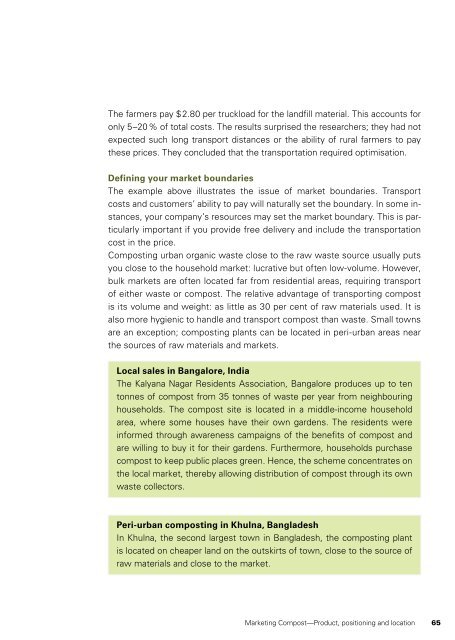Marketing Compost (EAWAG) - The Water, Sanitation and Hygiene
Marketing Compost (EAWAG) - The Water, Sanitation and Hygiene
Marketing Compost (EAWAG) - The Water, Sanitation and Hygiene
You also want an ePaper? Increase the reach of your titles
YUMPU automatically turns print PDFs into web optimized ePapers that Google loves.
<strong>The</strong> farmers pay $ 2.80 per truckload for the l<strong>and</strong>fill material. This accounts for<br />
only 5–20 % of total costs. <strong>The</strong> results surprised the researchers; they had not<br />
expected such long transport distances or the ability of rural farmers to pay<br />
these prices. <strong>The</strong>y concluded that the transportation required optimisation.<br />
Defining your market boundaries<br />
<strong>The</strong> example above illustrates the issue of market boundaries. Transport<br />
costs <strong>and</strong> customers’ ability to pay will naturally set the boundary. In some instances,<br />
your company’s resources may set the market boundary. This is particularly<br />
important if you provide free delivery <strong>and</strong> include the transportation<br />
cost in the price.<br />
<strong>Compost</strong>ing urban organic waste close to the raw waste source usually puts<br />
you close to the household market: lucrative but often low-volume. However,<br />
bulk markets are often located far from residential areas, requiring transport<br />
of either waste or compost. <strong>The</strong> relative advantage of transporting compost<br />
is its volume <strong>and</strong> weight: as little as 30 per cent of raw materials used. It is<br />
also more hygienic to h<strong>and</strong>le <strong>and</strong> transport compost than waste. Small towns<br />
are an exception; composting plants can be located in peri-urban areas near<br />
the sources of raw materials <strong>and</strong> markets.<br />
Local sales in Bangalore, India<br />
<strong>The</strong> Kalyana Nagar Residents Association, Bangalore produces up to ten<br />
tonnes of compost from 35 tonnes of waste per year from neighbouring<br />
households. <strong>The</strong> compost site is located in a middle-income household<br />
area, where some houses have their own gardens. <strong>The</strong> residents were<br />
informed through awareness campaigns of the benefits of compost <strong>and</strong><br />
are willing to buy it for their gardens. Furthermore, households purchase<br />
compost to keep public places green. Hence, the scheme concentrates on<br />
the local market, thereby allowing distribution of compost through its own<br />
waste collectors.<br />
Peri-urban composting in Khulna, Bangladesh<br />
In Khulna, the second largest town in Bangladesh, the composting plant<br />
is located on cheaper l<strong>and</strong> on the outskirts of town, close to the source of<br />
raw materials <strong>and</strong> close to the market.<br />
<strong>Marketing</strong> <strong>Compost</strong>—Product, positioning <strong>and</strong> location 65

















